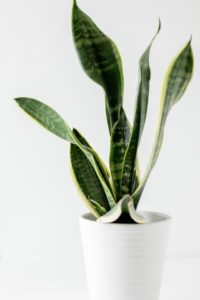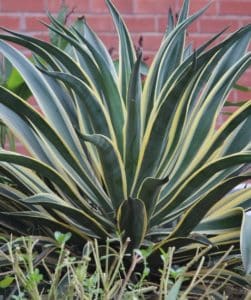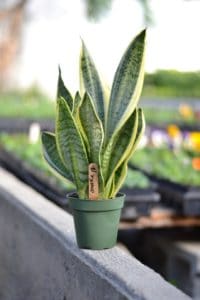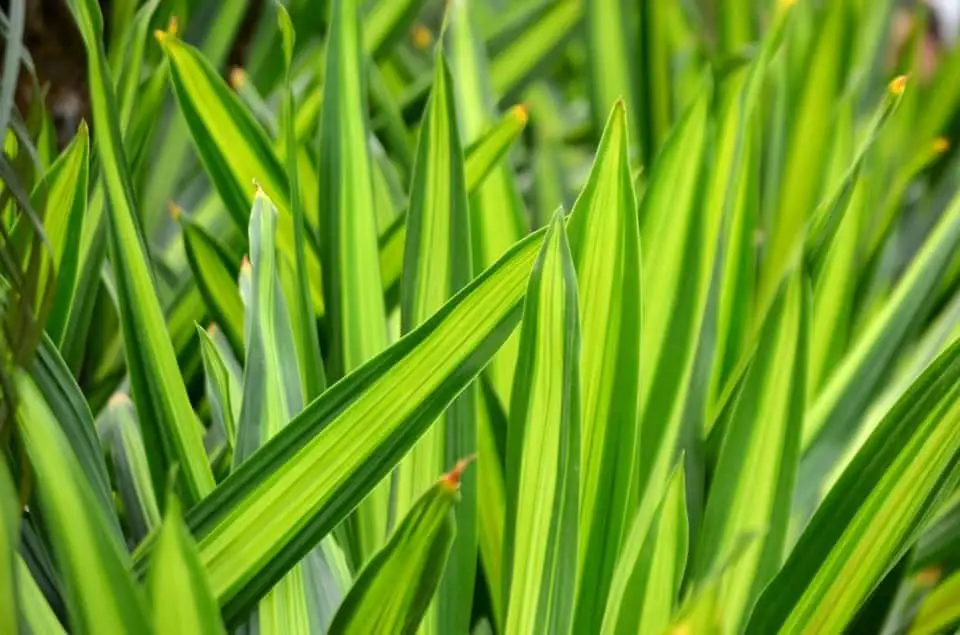Some links in the post are affiliate links and I get a commission from purchases made through some links found in the post.
You may have heard of this plant as a Mother-in-law’s tongue. It is also known as the Sansevieria trifasciata. Whichever name you know it by, you are sure to recognise it as it is very popular inside and outside the home.
It’s a great plant to have in pots on balconies as it does not take up more room than the size of the pot. Another good point is that snake plants do not drop leaves or dead blooms.
Snake plants are low maintenance, needing very little more than wiping the long leaves to prevent dust build up.
Before we look at your snake plant and root rot, let’s look at how to plant the snake plant and what conditions it likes.
How to Plant a Snake Plant
 Snake plants are slow growers so if the pot you bring it home in is intact and the roots are not growing out from the holes in the bottom, then you may be able to leave the plant in the pot, until you start to see roots at the base holes. They really do not need to be re-potted that often.
Snake plants are slow growers so if the pot you bring it home in is intact and the roots are not growing out from the holes in the bottom, then you may be able to leave the plant in the pot, until you start to see roots at the base holes. They really do not need to be re-potted that often.
If you plan to re-pot your snake plant, make sure that you select a pot which is slightly larger. Make sure that there are drainage holes. You should use regular house plant or cactus potting mix.
With a tall snake plant, you may want to be sure that it is in a heavy pot so that it does not topple over.
What Conditions does the Snake Plant Like?
Because it is native to West Africa and similar areas the snake plant does best in warmer climates. If the plant is exposed to cold temperatures the cell walls can be damaged and the plant can die from lack of moisture.
Ideally the best temperatures for a snake plant are in areas where the daytime temperatures are between 60-80 degrees F and the night temperatures are between 55-70 degrees F.
Let’s Talk about Root Rot
One of the most common issues with the snake plant is root rot, and because of this many plants simply do not survive.
Root rot is caused by overwatering, particularly in winter months when most plants need less water. Because there is a lack of oxygen, the roots die back or become infected by a soil fungus.
Wet, boggy soil encourages bacteria to grow and multiply. This spreads to the root system and infests the plant. Healthy roots start to become mushy and brown because they are not able to absorb the vital nutrients they need to grow.
One of the challenges with root rot is that all this takes place below the soil surface so we normally cannot see it, or do not notice it until it is too late to do much about it.
Drainage is so important to plants that in a pot with no holes, root rot can literally kill the entire plant within ten days.
What are the Signs that your Snake Plant has Root Rot?
The first visible sign of root rot are the leaves.
Classic Signs of Root Rot:
- Leaves turn brown
- Leaves become mushy
- Leaves start to droop
More Unusual Signs of Root Rot:
- Soft, dark spots close to the base of the stem. By the time you notice these, it is likely that the roots are already rotting.
- Wilting leaves. These can be caused by either overwatering or underwatering. It can also be caused by low humidity. If you notice any wilting leaves you should check first for root rot.
- Leaves turn yellow. This can be caused by either underwatering or overwatering but if the leaves are soft then this is most likely to be due to overwatering or poor drainage.
Further investigation should leave you inspecting the roots themselves for signs of root rot.
Gently lift the plant out of the soil and inspect the roots.
Black Mushy Roots
Because fungus thrives in damp soil, you will see with root rot that the roots of your snake plant are turning black and feel mushy.
While normal roots may be black or dark brown, they are not soft and mushy, rather they are firm to the touch.
Roots Pull Away
Another sign of root rot is when the roots easily pull away from the leaves when you handle then. Roots should, in a healthy plant, be firmly attached to the top part. They will only pull away if the plant suffers from root rot.
You may also like: 4 tips to care for a snake plant in the winter
What Causes Root Rot in your Snake Plant?
Overwatering
 The most common cause of root rot in snake plants is very simply overwatering. We all know that water is what keeps out plants alive, but too much of a good thing can harm them, as in the case of snake plants.
The most common cause of root rot in snake plants is very simply overwatering. We all know that water is what keeps out plants alive, but too much of a good thing can harm them, as in the case of snake plants.
Excess water will lead to root rot because the soil around the roots becomes saturated. Water accumulates and the outer layer of the roots also become saturated.
Because there may be so much water in the soil and around the roots, plants have difficulty taking in oxygen from the roots.
When there is not enough oxygen in the soil the roots of the snake plant will turn black.
Poor Drainage
If the pot you have placed your snake plant in does not have holes at the base, water will accumulate with nowhere to go. The soil will become boggy, and the plant health will be affected.
It is important that you use a pot which has enough depth for the snake plant to allow it to grow properly.
Potting Mix
Even if your pot has holes in and the drainage is good, the soil will still hold water unless it is the sort which allows for drainage.
A good quality compost will keep your plant in good health while allowing excess water to drain away.
Pot Size
Great big pots can have a negative effect on snake plants because large pots may allow excess water to remain in the soil and thus cause root rot.
The snake plant’s roots may be too small to reach all the areas of the pot and eventually water will build up in the soil.
Too Low Temperatures
Strangely enough placing your snake plant in a very cold area may cause root rot because the roots may freeze. If this happens they cannot take in any oxygen which results in the loss of nutrients.
Watering in Dormancy
As with many other plants the snake plant has a time when it goes dormant and does not grow. Extra water at this time may lead to standing water in the pot and soon after that root rot in the plant.
If you’re enjoying this article, check out our article on how big can a snake plant get.
How to Save your Snake Plant from Root Rot
Whether you manage to save your snake plant depends on the extent of the root rot. You will only know how much damage there is once you have removed the plant from the soil and inspected it.
- Gently remove the plant from the soil and take a good look at the roots.
- Remove any roots where you can see infection. You may have to untangle them to chop out the bad ones.
- Make sure that there are no remaining infected areas.
- Treat with a fungicide solution.
- Repot in a new pot which is sized for the plant.
- Make sure that the hole at the base allows water to drain through. A good idea is to place a porous material over the hole to stop any debris blocking it. Coffee filter papers are good for this.
- Use fresh potting mix and repot your plant.
Alternative Methods of Saving the Roots
If you prefer you can try natural methods to try to save your snake plant. Please remember that for these to work, they must be applied at the very first sign of root rot.
Apply to the soil’s surface and the lower area of your plant.
- Wood ash and chalk. Mix them in equal parts and apply to the roots.
- Potassium permanganate. You should dilute this until it is a very pale pink colour and then thoroughly soak the plant base. Important to use a large amount of water so as not to burn the plant.
- Copper sulphate and chalk paste. Use a mixture of 3 TBS powdered chalk, 1 TBS copper sulphate and 0.5 litres of water. Mix to a creamy paste and apply to the infected root system.
As with traditional methods you should also replace the potting mix with fresh and use a new pot to prevent re-infection.
Can we Save our Snake Plants from Root Rot?
Fortunately, the answer is you can save your snake plant from root rot, if you catch it early enough.
You must remove the rotted roots completely if the plant is to stand a chance of recovery.
After treatment you need to move the plant into a new location. You also need to stop overwatering it!
Because excess light may also be harmful to your plant, opt for an area where there is low to medium light, close to a window so the excess water can dry off from the plant leaves.
Refrain from watering the plant until the leaves no longer feel spongy and the soil is dry.
Adjust the watering schedule. A healthy snake plant may only need watering once a week, depending on the temperatures. In the winter months it should only need water around once a month.
It’s all about Drainage
Even if you have accidentally overwatered your snake plant, if the potting mix has good drainage and the pot has a hole (or more then one) at the base, your snake plant will adjust because the water drains away.
However, if you constantly overwater and there is no drainage in the soil or the pot, then it is most likely that your snake plant will develop root rot and die.
Final Thoughts
 Snake plants are not temperamental plants and neither do they need enormous amounts of maintenance to do well.
Snake plants are not temperamental plants and neither do they need enormous amounts of maintenance to do well.
What they do need is dry soil which drains well, in a pot with holes. They do not need to be watered every day along with other pot plants, so it is worth noting on your kitchen calendar when you are due to water them.
If you have managed to save your snake plant from root rot you should make sure to repot using fresh soil and a clean pot. If you need to make any cuts to the roots, be sure to use sterilized cutting shears and wash them well after use.
With a little planning – and less watering – there is no reason why your garden, house or patio should not have some of these beautiful plants all your round.
If you enjoyed this article, check out our article on why does your snake plant have no roots.

